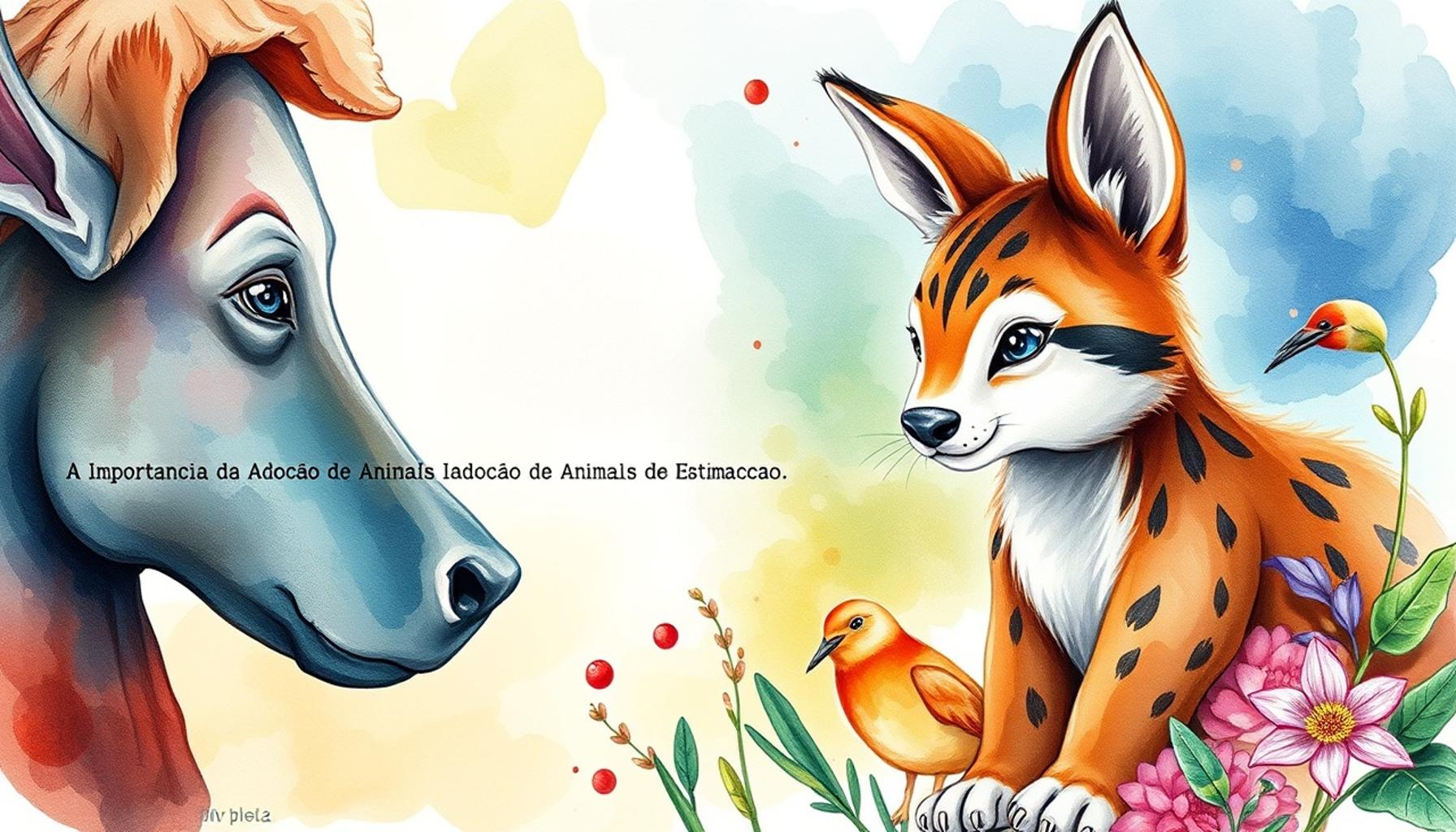The Adoption of Animals in Times of Crisis: How the Pandemic Changed the Adoption Landscape

The Impact of the Pandemic on Animal Adoption Trends
In the face of unprecedented challenges, the bond between humans and animals has been redefined. The COVID-19 pandemic acted as a catalyst, significantly altering the animal adoption landscape across the United States. Shelters and rescue organizations observed emerging trends that reshaped the way people viewed pet companionship during tough times, reflecting both human needs for connection and the welfare of animals.
Increased Adoption Rates
As lockdowns and social distancing measures took effect, many animal shelters reported a remarkable surge in adoptions. For example, the ASPCA noted a 70% increase in their adoption rates during the initial months of the pandemic compared to the previous year. People sought solace and companionship during these isolating times, leading to a widespread movement toward adopting pets. This was not merely a trend but a search for emotional support; many individuals found relief in the joyful antics and unwavering loyalty of newly adopted pets.
Virtual Adoption Processes
To accommodate growing demand while ensuring safety, shelters rapidly adapted their strategies. Creative solutions, such as virtual meet-and-greets and video introductions, became standard to facilitate the adoption experience. Potential adopters could engage with pets via Zoom calls, allowing them to assess compatibility without physical interactions. This not only kept the community safe but also made the adoption process more accessible, reaching individuals who might not have visited shelters in person. Moreover, online platforms like Petfinder and Adopt-a-Pet saw a significant rise in traffic, making it easier for people to find animals in need of homes.
Change in Demographics
The demographics of those adopting pets also transformed during this period. Families, young individuals, and even seniors became part of this growing community of animal lovers. For instance, studies indicated an increase in pet ownership among millennials and Gen Z, who viewed pets not just as companions but as integral members of their households. This diversification in the adoption audience not only expanded the market for shelters but also highlighted a cultural shift in the perception of pet ownership, as more people sought to share their lives with animals.
This shift did not just change the number of adoptions; it also transformed the relationship between owners and their pets. As people spent more time at home, the significance of pet ownership was magnified, leading to a renewed interest in animal welfare. The increased visibility of pet adoption and advocacy raised public awareness, encouraging conversations about the importance of responsible pet ownership and the implications of pet abandonment.

Organizations adapted by implementing innovative programs to ensure animals found loving homes. Traffic on adoption websites skyrocketed, leading to an exploration of the connection between crisis and care. For instance, many shelters organized promotional events and fundraising campaigns to support animals in need, driving community engagement. Understanding these dynamics opens doors to new conversations about animal welfare, community resilience, and the vital role pets play in enhancing our emotional well-being. Amid challenges, the response of communities towards animal adoption reveals not only compassion but also an evolving understanding of the human-animal bond, strengthening the case for advocating for animal welfare in broader societal contexts.
LEARN MORE: Click here to discover how adopting pets can make a difference
Transformative Influences on Shelters and Communities
As the pandemic unfolded, animal shelters and rescue organizations found themselves navigating uncharted territory, both operationally and emotionally. The necessity to streamline adoption processes emerged quickly as staff and volunteers worked tirelessly to maintain safe environments for both humans and animals. Resources were redirected towards enhancing virtual services and promoting the wellbeing of the animals in their care. This moment of crisis elicited a community response that revealed the resilient spirit of pet lovers across the nation.
Innovations in Shelter Operations
The pandemic prompted shelters to innovate swiftly, implementing strategies that would engage potential adopters while adhering to health guidelines. Some of the most effective practices included:
- Virtual Events: Online adoption fairs and “meet your match” days allowed potential adopters to interact with animals in a safe setting.
- Social Media Campaigns: Shelters harnessed the power of social media, sharing heartwarming stories and videos of animals available for adoption, creating an emotional connection with viewers.
- Foster-to-Adopt Programs: This model enabled individuals to temporarily take home a pet, providing them the opportunity to bond before committing long-term.
These innovative solutions not only enhanced community engagement but also streamlined the adoption journey. The pivot to digital platforms allowed shelters to reach broader audiences, harnessing the power of technology to connect with individuals who had never considered adopting before.
Community Spirit and Volunteer Mobilization
During the pandemic, the spirit of communities across the U.S. was ignited. Volunteers stepped up in unprecedented ways to ensure that shelters could continue their life-saving work. Many individuals who had time on their hands during lockdown took the opportunity to support local shelters, whether through fostering animals, fundraising, or spreading awareness about pet adoption. Shelter staff reported an influx of volunteers, many of whom remained involved even after life began to return to normal.
The partnership between communities and animal shelters became even more pronounced, revealing a shared commitment to animal welfare. Local businesses contributed by sponsoring adoption events and providing necessary supplies, fostering a sense of collective responsibility. The relationship between humans and animals evolved during this time, as pets were no longer viewed solely as companions, but as essential members of families—offering comfort during an emotionally challenging period.
The Long-Term Effects of Increased Adoption
The spike in animal adoptions during the pandemic has significantly impacted not only shelters but also the broader conversation surrounding animal welfare. The implications of this surge raise important questions regarding the sustainability of pet ownership, access to resources for new pet owners, and the long-term welfare of animals. As families embraced their new companions, discussions surrounding responsible pet ownership began to flourish. New pet owners started to recognize the importance of training, socialization, and routine veterinary care, which contributed to healthier and happier pets overall.
This pivotal moment in animal adoption history demonstrates how crisis can indeed act as a motivator for positive change. As organizations adapt and communities rally together to support the welfare of animals, we can gain valuable insights into fostering lifelong connections between pets and their humans, shaping a future where animal adoption becomes a normalized essential part of our society.
During the pandemic, the conditions that propelled the adoption of pets were multifaceted. Many individuals found themselves confined to their homes, leading to an unprecedented surge in interest in animal companionship. This phenomenon can largely be attributed to the growing understanding of how pets can serve as emotional support during times of crisis. The act of adopting an animal became not only a means of safeguarding one’s mental health but also brought a sense of purpose and routine amidst the chaos of lockdowns.Shelters and rescue organizations experienced a remarkable transformation in their operations. With traditional adoption events on hold, many facilities pivoted to virtual adoption processes, utilizing online platforms and social media to showcase animals in need of homes. This innovation not only expanded their reach but also created a more efficient way of matching pets to prospective owners. Moreover, data revealed that many of these adoptions resulted in long-term commitments, indicating a lasting change in the way society views animal companionship.As people began to understand the profound benefits of pet ownership, such as increased physical activity from walks and the emotional comfort derived from snuggling with a furry friend, they became more invested in their roles as pet parents. This shift in perspective has sparked discussions about responsible ownership, highlighting the importance of proper training, socialization, and regular veterinary care.Remarkably, the pandemic has also ignited conversations around fostering animals, where people provide temporary homes to pets in need. This has not only alleviated the pressure on overburdened shelters but also allowed potential adopters to assess the compatibility of a pet before committing to a permanent adoption. The surge in foster arrangements has unveiled an unexpected layer of community support, where individuals band together to care for vulnerable animals, showcasing the resilience of human compassion in times of crisis.As the adoption landscape continues to evolve, the pandemic’s legacy brings forth a movement toward advocacy and awareness in animal welfare. The dramatic shift in attitudes and practices during this time suggests a promising future for animal rescue initiatives, thriving not just on the premises of convenience but on the survival and well-being of countless animals awaiting loving homes. The extended impact of these changes raises vital questions about the long-term effects of the pandemic on how society interacts with animals, and we can only anticipate that this newfound bond will foster a sustainable culture of responsible pet ownership and empathetic involvement in animal welfare for years to come.
DISCOVER MORE: Click here to learn about the importance of nutrition for your pets
The Evolution of Adoption Perceptions
The landscape of animal adoption has undergone profound shifts due to the pandemic, reshaping how communities view pet ownership and, importantly, the animals themselves. This crisis highlighted the need for companionship, but it also ignited conversations about accountability and responsibility among pet owners. As families adapted to a new normal, the presence of pets soared in importance, leading to a greater awareness of the role these animals play in well-being.
The Rise of Informed Adoption Decisions
With the surge in adoptions, there has been a parallel demand for education on effective pet ownership. Organizations increasingly emphasized the significance of informed decision-making when adopting a pet. Access to curated resources, like webinars and online workshops, provided potential adopters with essential guidance. These educational initiatives covered a range of topics including choosing the right breed, understanding behavioral needs, and the financial implications of long-term pet care.
Statistics reveal that the average adoption rate increased by approximately 30% in many shelters during peak pandemic months, indicating a robust interest in adding furry companions to households. During this time, shelters began to implement mandatory training sessions for adoptive families, fostering a culture of responsibility from the outset. The goal was to ensure that families were readily equipped to meet the needs of their new pets and to minimize the risk of future abandonment, which often spikes post-holiday seasons and crisis periods.
Impact on Specific Demographics
The demographic landscape of pet adopters also changed during the pandemic. With many remote workers and those finding themselves in isolation looking for companionship, it became apparent that traditional notions of “pet owners” were evolving. A study conducted by the ASPCA indicated that 77% of first-time pet owners during the pandemic were individuals under the age of 35. This rise among younger adults suggested that a growing segment of the population began to embrace the idea of adopting pets as not just a temporary need but as a long-term lifestyle choice.
Moreover, the push toward adoption transcended age barriers, with families seeing the addition of a pet as a way to instill a sense of responsibility in young children or as a bonding experience for families navigating the challenges of social distancing. As communities sought ways to support one another during the pandemic, the power of pet companionship emerged as a critical element in enhancing emotional well-being.
Long-Term Societal Changes and the Role of Technology
The integration of technology into the adoption process also marked a significant evolution. As discussed earlier, many shelters adopted virtual platforms for showcasing animals. This digital push resulted in an increase in adoption applications, with some shelters reporting up to 50% more applications than before the pandemic. The success of these online initiatives likely suggests that shelters will continue leveraging technology for future adoptions, extending their reach and making it easier for pet seekers to find the right match.
Furthermore, the pandemic fostered a long-lasting relationship between adoption agencies and tech companies, leading to streamlined processes and more sophisticated tools for education and adoption tracking. Some organizations have even created mobile apps to facilitate easier access to animal care resources and foster connections between adopters and shelters long after the adoption is finalized.
This shifting paradigm of animal adoption during a crisis signifies a recalibrated understanding of the human-animal bond, underscoring the necessity of lifelong commitment to pet ownership and illuminating potential paths for future growth in adoption practices and policies. The pandemic has not only changed situational dynamics but also paved the way for a more resilient, informed, and community-focused approach to animal welfare.
LEARN MORE: Click here to discover the importance of balanced nutrition for your pet
Conclusion: A New Era for Animal Adoption
The COVID-19 pandemic has undeniably transformed the narrative around animal adoption, ushering in a new era marked by heightened awareness, responsibility, and community engagement. As we navigate the aftermath of this crisis, the increased adoption rates—rising by approximately 30% among shelters—highlight a collective shift in the understanding of pet ownership as a long-term commitment rather than a fleeting desire.
This adoption surge has been complemented by a growing emphasis on education regarding pet care, fostering a culture that prioritizes informed decisions and responsible ownership. From virtual workshops to technology-enabled platforms, resources have evolved to ensure that both potential and current pet owners are well-equipped with knowledge and skills to provide lasting care for their furry companions.
Furthermore, the demographic landscape of pet adopters has broadened, with 77% of first-time pet owners being individuals under 35, highlighting the engagement of younger generations amidst a quest for companionship during isolating times. This trend not only reflects shifting perceptions of ownership but also points to a deeper societal acknowledgment of the profound emotional benefits pets bring, particularly during challenging periods.
As we move forward, the integration of technology and ongoing support from adoption agencies promise to further enrich the adoption process, making it more accessible and sustainable. The pandemic has catalyzed a long-lasting change, driving a community-focused approach to animal welfare that will likely shape the future of adoption practices. For many, their adopted pets have become invaluable sources of companionship, solitude-busters, and emotional anchors during uncertain times, underscoring the vital role of animals in enhancing human well-being.
Ultimately, this evolving landscape not only reshuffles the traditional views on pet adoption but also encourages society to prioritize the welfare of animals, ensuring that the bonds formed during these unprecedented times lead to enriched lives for both pets and their families.


